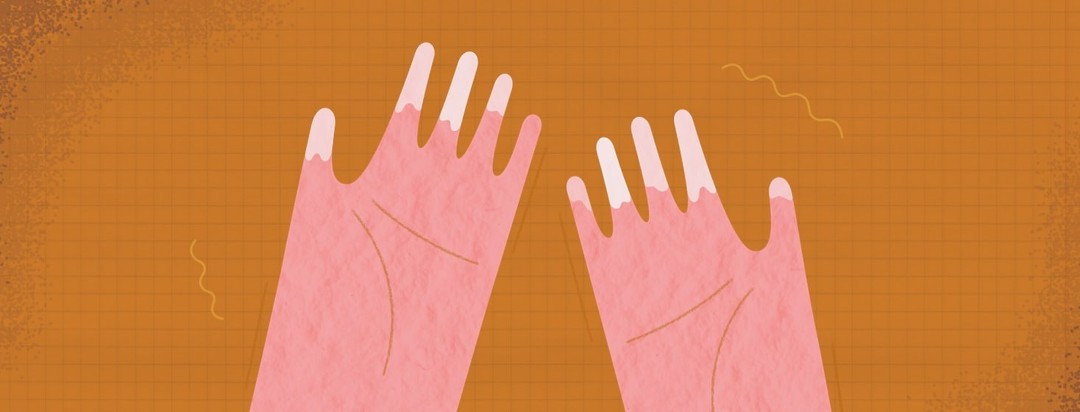Raynaud's Disease
Now that the weather has turned (much) colder in Minnesota, my swollen and inflamed joints are happier thanks to the cool, dry weather. The heat and especially the humidity of summer usually inflict severe misery on my joints and overall health. Chilly fall and winter weather is always a welcome change for me and my body. Except for one uncomfortable and annoying condition that I often forget that I have: Raynaud's disease.
What is Raynaud's disease?
According to the Mayo Clinic, "Raynaud's disease (also known as Raynaud's phenomenon or syndrome) causes some areas of your body—such as your fingers and toes—to feel numb and cold in response to cold temperatures or stress. In Raynaud's disease, smaller arteries that supply blood to your skin narrow, limiting blood circulation to affected areas (vasospasm)."1
Raynaud's isn't simply a matter of numb fingers and toes, but it can also change the appearance and color of the afflicted digits. The tips of fingers (sometimes nearly the entire finger) can turn a disturbing shade of white and look and feel like creepy, dead appendages. The cold-numb feeling also isn't just an annoyance, but it can be quite uncomfortable and almost painful--especially if you're trying to do something (writing, opening things, driving).
Symptoms of Raynaud's disease
One day a few weeks ago the temperature dropped abnormally low, even for Minnesota, and I was walking around in my cold house barefoot. I'm usually barefoot if it's not arctic-cold because my painful RA feet and ankles are sensitive and don't like socks. On this day, however, socks proved to be necessary as I suddenly felt the familiar dull, numb pangs of Raynaud's disease attack my feet.
I couldn't feel three of my toes anymore. I bent over and peered at my right foot. Yep, the ghostly toes were back: strange, solid-white things sucked of all life.How annoying. I tried to jab my toes into the carpet and I was met with rock-solid numbness. Then I quickly grabbed a pair of socks and rubbed my feet, trying to warm up and get some blood flowing again. It took quite a while for my toes to return to normal.
So what does all of this have to do with RA? There is a connection, I swear.
Raynaud's disease and autoimmune diseases
While Raynaud's isn't an autoimmune disease, people who have chronic, autoimmune diseases (such as RA, lupus, scleroderma) are more likely to develop it. Also similar to RA, more women get the disease than men do. And, as with autoimmune diseases, there is no exact known cause of Raynaud's disease--nor a cure.
How does Raynaud's occur?
According to Johns Hopkins Medicine: Raynaud’s can occur on its own, known as primary form. Or it may happen along with other diseases, known as secondary form. The diseases most often linked with Raynaud’s are autoimmune or connective tissue diseases such as:
- Lupus (systemic lupus erythematous)
- Scleroderma
- CREST syndrome (a form of scleroderma)
- Buerger disease
- Sjögren's syndrome
- Rheumatoid arthritis
- Occlusive vascular disease, such as atherosclerosis
- Polymyositis
- Blood disorders, such as Cryoglobulinemia
- Thyroid disorders
- Pulmonary hypertension2
The primary form of Raynaud’s is the most common type. It often begins between ages 15 and 25 and it's less severe than secondary Raynaud’s. People with primary Raynaud’s do not often develop a related condition.
Risk factors
Interestingly, I developed Raynaud's myself a couple years after being diagnosed with RA. I was probably around age 20-21, I think. And while my Raynaud's "attacks" have always been fairly mild, my younger sister gets pretty severe ones. She does not have RA, yet she has an autoimmune thyroid condition (Hashimoto's disease) and developed Raynaud's around age 19. This makes me assume that we both have the primary form of Raynaud's, despite also living with autoimmune diseases.
Risk factors of Raynaud's disease
According to Johns Hopkins, there are certain factors that can increase one's risk of developing Raynaud's disease, such as:
- A connective tissue or autoimmune disease
- Chemical exposure
- Cigarette smoking
- Injury or trauma
- Repetitive actions, such as typing or use of tools that vibrate like a jack hammer
- Side effects from certain medicines2
How to learn more
If you have Raynaud's or you just want to read more about it, the two sources I used for this article, from The Mayo Clinic and Johns Hopkins, have even more detailed information on their websites (symptoms, risk factors, possible causes, treatment). There are other great sources online too, of course.
Most of the time, I forget that I even have Raynaud's disease, except when it decides to randomly attack my fingers and toes. And now that it's been happening again lately, I wonder: Who else with RA has this condition? I'm curious to know! What's yours like? Mild, moderate, severe? Do you get what I mean when I mention the "ghostly toes" and the strange, numb feeling?
If you are struggling with this irritating cold-weather condition, hang in there, because I'm dealing with it too. You're not alone. And make sure that you stock up on plenty of gloves and warm socks this winter!

Join the conversation